See Page 1 |
2 |
3 |
4 | of the March 2024 homepage archives. Thursday the 7th
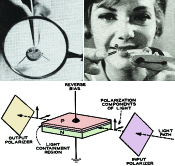 In 1967 when this set of
News Briefs was published in Radio-Electronics magazine, the use of
semiconductors in laser light applications was the domain of government, corporate,
and university research laboratories. The device only modulated the beam. It did
not generate the beam, although as seen below infrared laser diodes were already
in the works. Also wowing the readership was a pinhead-size gallium arsenide (GaAs)
transmitter which could generate frequency modulated (FM) signals in the 60 MHz
to 2.5 GHz range. The "highest ever" starting salary for engineering students
in that year was a whopping $166/week, or $8,632/year. That is the equivalent of
$80,674 in 2024 money. By comparison, $16/hour fast food workers in California are
pulling in $33,280/year, and qualify for many welfare benefits and healthcare. A
really interesting item is how a group of British high school radio enthusiasts
routinely tracked Russian satellite orbits to reverse engineer the point of launch,
and on occasion discovered new ground bases, like the Plesetsk Cosmodrome in Mirny. In 1967 when this set of
News Briefs was published in Radio-Electronics magazine, the use of
semiconductors in laser light applications was the domain of government, corporate,
and university research laboratories. The device only modulated the beam. It did
not generate the beam, although as seen below infrared laser diodes were already
in the works. Also wowing the readership was a pinhead-size gallium arsenide (GaAs)
transmitter which could generate frequency modulated (FM) signals in the 60 MHz
to 2.5 GHz range. The "highest ever" starting salary for engineering students
in that year was a whopping $166/week, or $8,632/year. That is the equivalent of
$80,674 in 2024 money. By comparison, $16/hour fast food workers in California are
pulling in $33,280/year, and qualify for many welfare benefits and healthcare. A
really interesting item is how a group of British high school radio enthusiasts
routinely tracked Russian satellite orbits to reverse engineer the point of launch,
and on occasion discovered new ground bases, like the Plesetsk Cosmodrome in Mirny.
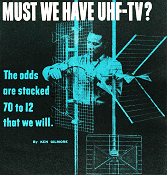 When
UHF broadcast television was being introduced, pundits - as pundits are wont
to do - were quick to predict the rapid, imminent demise of VHF channels. To wit,
"All current VHF stations (operating on channels 2 through 13) may be scrapped,
and operations shifted to the UHF band." That was in 1962, when the first experimental
UHF station (WUHF) went on-air in New York City. Cited as the reason was a supposed
inability for the two bands to co-exist. History - as it is wont to do - proved
otherwise, due largely to UHF signals' inability to bend around natural and manmade
obstruction to provide a clear signal. VHF channels 2-6 are on 54-82 MHz, 7-13
are on 174-210 MHz, and UHF channels 14-83 are on 470-884 MHz. This 1962
Popular Electronics magazine story is a very nice account of the early
days of UHF television broadcasting... When
UHF broadcast television was being introduced, pundits - as pundits are wont
to do - were quick to predict the rapid, imminent demise of VHF channels. To wit,
"All current VHF stations (operating on channels 2 through 13) may be scrapped,
and operations shifted to the UHF band." That was in 1962, when the first experimental
UHF station (WUHF) went on-air in New York City. Cited as the reason was a supposed
inability for the two bands to co-exist. History - as it is wont to do - proved
otherwise, due largely to UHF signals' inability to bend around natural and manmade
obstruction to provide a clear signal. VHF channels 2-6 are on 54-82 MHz, 7-13
are on 174-210 MHz, and UHF channels 14-83 are on 470-884 MHz. This 1962
Popular Electronics magazine story is a very nice account of the early
days of UHF television broadcasting...
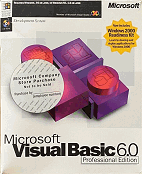 Do
you have a copy of Visual Basic v6.0 Professional or Enterprise that you are
willing to sell or swap for RF Cafe software? My VB6 was sold long ago, but now
I would like to work on some old programs. Believe it or not, VB6 programs will
still run on Windows 11.
eBay sellers are getting anywhere from $10-$150, depending on the version. I
need at least the Pro version. I could just buy one off eBay, but surely someone
out there has an unused copy sitting around. Thanks - Kirt B. (kirtrfc@aol.com) Do
you have a copy of Visual Basic v6.0 Professional or Enterprise that you are
willing to sell or swap for RF Cafe software? My VB6 was sold long ago, but now
I would like to work on some old programs. Believe it or not, VB6 programs will
still run on Windows 11.
eBay sellers are getting anywhere from $10-$150, depending on the version. I
need at least the Pro version. I could just buy one off eBay, but surely someone
out there has an unused copy sitting around. Thanks - Kirt B. (kirtrfc@aol.com)
 Here's a March 6th headline from the
Associated Press: "Fact
Focus: Claims Biden administration is secretly flying migrants into the country
are unfounded." It addresses recent reports that in the past year, more than 300,000
"migrants" have been flown into U.S. airports by the government. Author Elliot Spagat's
keen intellect and masterful sleuthing abilities discovered that while it is
true that more than 300,000 have been flow in, it wasn't
a secret - it was only "enigmatic" and "lacking in transparency." Oh, and they're
not coming from "who knows where," but specifically from Cuba (60k), Haiti(126k),
Nicaragua(53k), and Venezuela(81), implying that unlike the millions pouring in
over the Mexican border which includes people from African, Asian, and Middle Eastern
countries, you can be sure none of that group are mixed in. Unmarried, military-age
men make up a large, disproportionate percentage of the "migrants." Another ruse
is reporting "illegal migrants," which excludes the huge number of "refugees," which
is a huge number. Illegal + refugee is in the many millions. This is the very definition
of gas lighting. Here's a March 6th headline from the
Associated Press: "Fact
Focus: Claims Biden administration is secretly flying migrants into the country
are unfounded." It addresses recent reports that in the past year, more than 300,000
"migrants" have been flown into U.S. airports by the government. Author Elliot Spagat's
keen intellect and masterful sleuthing abilities discovered that while it is
true that more than 300,000 have been flow in, it wasn't
a secret - it was only "enigmatic" and "lacking in transparency." Oh, and they're
not coming from "who knows where," but specifically from Cuba (60k), Haiti(126k),
Nicaragua(53k), and Venezuela(81), implying that unlike the millions pouring in
over the Mexican border which includes people from African, Asian, and Middle Eastern
countries, you can be sure none of that group are mixed in. Unmarried, military-age
men make up a large, disproportionate percentage of the "migrants." Another ruse
is reporting "illegal migrants," which excludes the huge number of "refugees," which
is a huge number. Illegal + refugee is in the many millions. This is the very definition
of gas lighting.
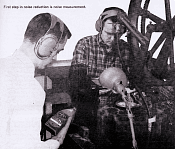 This article on noise measurement is not
about electrical noise, but rather on
audible noise. It appeared in a 1973 edition of Popular Electronics
magazine during an era when hi-fi stereo equipment was becoming a big deal. Author
Carl Alsen, an engineer at General Radio, reviews methods of sound level measurement
and gives values for some usual and unusual sources typically found in manufacturing
environments, like a punch press, pneumatics rock drill, office and restaurant environments,
and the rustling of leaves. Radio manufacturers had/have a vested interest in background
noise that affects the satisfaction of their customers. Ambient noise in all realms
has been a rapidly growing problem in terms of information transmission and reception.
Many articles were written about background interferences in the decades of the
1960s and 1970s as more and more people became engaged (e.g., Electronic Pollution
... An Impending Crisis, Acoustical Tile - A New Hi-Fi Component, The Dolby Technique
for Reducing Noise, etc.)... This article on noise measurement is not
about electrical noise, but rather on
audible noise. It appeared in a 1973 edition of Popular Electronics
magazine during an era when hi-fi stereo equipment was becoming a big deal. Author
Carl Alsen, an engineer at General Radio, reviews methods of sound level measurement
and gives values for some usual and unusual sources typically found in manufacturing
environments, like a punch press, pneumatics rock drill, office and restaurant environments,
and the rustling of leaves. Radio manufacturers had/have a vested interest in background
noise that affects the satisfaction of their customers. Ambient noise in all realms
has been a rapidly growing problem in terms of information transmission and reception.
Many articles were written about background interferences in the decades of the
1960s and 1970s as more and more people became engaged (e.g., Electronic Pollution
... An Impending Crisis, Acoustical Tile - A New Hi-Fi Component, The Dolby Technique
for Reducing Noise, etc.)...
 With more than 1000
custom-built symbols, this has got to be the most comprehensive set of
Visio Symbols
available for RF, analog, and digital system and schematic drawings! Every object
has been built to fit proportionally on the provided A-, B- and C-size drawing page
templates (or can use your own). Symbols are provided for equipment racks and test
equipment, system block diagrams, conceptual drawings, and schematics. Unlike previous
versions, these are NOT Stencils, but instead are all contained on tabbed pages
within a single Visio document. That puts everything in front of you in its full
glory. Just copy and paste what you need on your drawing... With more than 1000
custom-built symbols, this has got to be the most comprehensive set of
Visio Symbols
available for RF, analog, and digital system and schematic drawings! Every object
has been built to fit proportionally on the provided A-, B- and C-size drawing page
templates (or can use your own). Symbols are provided for equipment racks and test
equipment, system block diagrams, conceptual drawings, and schematics. Unlike previous
versions, these are NOT Stencils, but instead are all contained on tabbed pages
within a single Visio document. That puts everything in front of you in its full
glory. Just copy and paste what you need on your drawing...
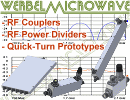 Werbel Microwave is a manufacturer of RF
directional and bidirectional couplers (6 dB to 30 dB) and RF power dividers
/ combiners (2- to 16-way) with select models operating up to 26.5 GHz and
100 W of CW power (3 kW peak). All are RoHS and REACH compliant and are
designed and manufactured in our Whippany, NJ, location. Custom products and private
label service available. Please take a couple minutes to visit their website and
see how Werbel Microwave can help you today. Werbel Microwave is a manufacturer of RF
directional and bidirectional couplers (6 dB to 30 dB) and RF power dividers
/ combiners (2- to 16-way) with select models operating up to 26.5 GHz and
100 W of CW power (3 kW peak). All are RoHS and REACH compliant and are
designed and manufactured in our Whippany, NJ, location. Custom products and private
label service available. Please take a couple minutes to visit their website and
see how Werbel Microwave can help you today.
Wednesday the 6th
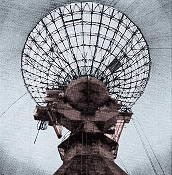 In 1967 when this story about
Canada's first satellite earth station, located 85 miles north of Halifax, Nova
Scotia, appeared in Radio-Electronics magazine, government bureaucrats who oversaw
the allocation of operational privilege within the realm of electromagnetic radiation
worked at the Department of Transport. To some extent that makes sense since information
is being transported from point A to point B. That department presently
is titled Transport Canada. However, control of the EM spectrum is now the purview
of the Canadian Radio-television and Telecommunications Commission (CRTC), which
is the equivalent of the U.S.'s FCC. What would the world do without ever-expanding
governmental powers over industry and society? We are truly blessed to have such
supremely wise, intelligent, sentient beings controlling everything. No wonder today's
world is so orderly and just ...but I digress. This antenna was one of only three
such installations at the time in North America. Satellites were being launched
with a relatively high regularity, so the population grew quickly after that. I
double-checked to be sure I did not incorrectly copy the text where the author states
a power level of -100 dB. That, of course, should have been dBm, since dB is
a unitless ratio, not a power level. A search for an explanation of why satellites
are referred to as "birds" did not turn up a definitive source. Supposedly the nickname
"Early Bird" for Intelsat I stemmed from the old saying "the early bird catches
the worm'" i.e. dominating the satellite industry. Other sources say "bird" refers
to the satellite's path across the sky or that they have a bird's-eye view of the
Earth... In 1967 when this story about
Canada's first satellite earth station, located 85 miles north of Halifax, Nova
Scotia, appeared in Radio-Electronics magazine, government bureaucrats who oversaw
the allocation of operational privilege within the realm of electromagnetic radiation
worked at the Department of Transport. To some extent that makes sense since information
is being transported from point A to point B. That department presently
is titled Transport Canada. However, control of the EM spectrum is now the purview
of the Canadian Radio-television and Telecommunications Commission (CRTC), which
is the equivalent of the U.S.'s FCC. What would the world do without ever-expanding
governmental powers over industry and society? We are truly blessed to have such
supremely wise, intelligent, sentient beings controlling everything. No wonder today's
world is so orderly and just ...but I digress. This antenna was one of only three
such installations at the time in North America. Satellites were being launched
with a relatively high regularity, so the population grew quickly after that. I
double-checked to be sure I did not incorrectly copy the text where the author states
a power level of -100 dB. That, of course, should have been dBm, since dB is
a unitless ratio, not a power level. A search for an explanation of why satellites
are referred to as "birds" did not turn up a definitive source. Supposedly the nickname
"Early Bird" for Intelsat I stemmed from the old saying "the early bird catches
the worm'" i.e. dominating the satellite industry. Other sources say "bird" refers
to the satellite's path across the sky or that they have a bird's-eye view of the
Earth...
 One of the first things a knowledgeable restorer
of vintage electronic gear does prior to plugging in a newly acquired piece of hardware
is to replace all of the original paper capacitors. Those things notoriously lose
the internally contained smoke that makes them work soon after power is applied.
Episodes of conflagration often ensue. According to Mac McGregor in this 1972 "Mac's
Service Shop" docudrama published in Popular Electronics magazine,
the typical shelf life of a paper capacitor (and some mica and ceramics back in
the day) is about five years. In that time the insulation resistance can drop from
5000 MΩ to less than 2 MΩ. Ohm's Law quickly reveals that with used across
a 300 V plate bias supply circuit, the leakage current can be 0.15 mA,
and dissipate 45 mW of power. Considering the number of such connections in
products like the RCA Victor Model VHR-307 Home Recording Phono-Radio Combination,
the current and power can add up quickly, and the generated thermal noise can get
significant. These articles, while apparently an electronics serviceman saga, is
actually meant to be instructive to readers, many of whom were service shop owners
or employees... One of the first things a knowledgeable restorer
of vintage electronic gear does prior to plugging in a newly acquired piece of hardware
is to replace all of the original paper capacitors. Those things notoriously lose
the internally contained smoke that makes them work soon after power is applied.
Episodes of conflagration often ensue. According to Mac McGregor in this 1972 "Mac's
Service Shop" docudrama published in Popular Electronics magazine,
the typical shelf life of a paper capacitor (and some mica and ceramics back in
the day) is about five years. In that time the insulation resistance can drop from
5000 MΩ to less than 2 MΩ. Ohm's Law quickly reveals that with used across
a 300 V plate bias supply circuit, the leakage current can be 0.15 mA,
and dissipate 45 mW of power. Considering the number of such connections in
products like the RCA Victor Model VHR-307 Home Recording Phono-Radio Combination,
the current and power can add up quickly, and the generated thermal noise can get
significant. These articles, while apparently an electronics serviceman saga, is
actually meant to be instructive to readers, many of whom were service shop owners
or employees...
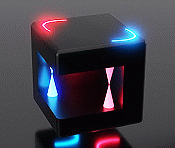 "Researchers at the Leibniz Institute for
Solid State and Materials Research at IFW Dresden, Germany, have found proof for
surface superconductivity in a class of topological materials known as
Weyl semimetals. Interestingly, the superconductivity, which comes from electrons
confined in so-called Fermi arcs, is slightly different on the top and bottom surfaces
of the sample studied. The phenomenon could be used to create Majorana states –
long-sought after quasiparticles that could make extremely stable, fault-tolerant
quantum bits for next-generation quantum computers. Meanwhile, another group at
Penn State University in the US has fabricated a chiral topological superconductor
by combining two magnetic materials. Majorana states might also be found in this
new material. Topological insulators are insulating in the bulk but conduct electricity
extremely well on their edges via special, topologically protected, electronic states.
These topological states are protected from fluctuations in their environment and
electrons in them do not backscatter. Since backscattering is the main dissipating
process in electronics, this means that these materials might be used to make highly
energy-efficient electronic devices in the future..." "Researchers at the Leibniz Institute for
Solid State and Materials Research at IFW Dresden, Germany, have found proof for
surface superconductivity in a class of topological materials known as
Weyl semimetals. Interestingly, the superconductivity, which comes from electrons
confined in so-called Fermi arcs, is slightly different on the top and bottom surfaces
of the sample studied. The phenomenon could be used to create Majorana states –
long-sought after quasiparticles that could make extremely stable, fault-tolerant
quantum bits for next-generation quantum computers. Meanwhile, another group at
Penn State University in the US has fabricated a chiral topological superconductor
by combining two magnetic materials. Majorana states might also be found in this
new material. Topological insulators are insulating in the bulk but conduct electricity
extremely well on their edges via special, topologically protected, electronic states.
These topological states are protected from fluctuations in their environment and
electrons in them do not backscatter. Since backscattering is the main dissipating
process in electronics, this means that these materials might be used to make highly
energy-efficient electronic devices in the future..."
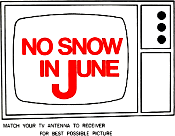 Few homeowners in the era of television
antennas on the roof had any knowledge at all about how the antenna and
twin lead transmission line system worked. Even those who were familiar with
it only knew the basics like keeping the transmission line away from metallic objects
and properly terminating the ends. I have seen photographs from servicemen of twin
lead laying in aluminum guttering and along the top of chain link fence rail, and
amazingly, the TV set still received a fairly good picture. That must have been
in areas with exceptionally strong signals. This article in a 1970 issue of
Popular Electronics magazine described a method for optimizing the antenna
and transmission line in terms of impedance matching and using very low loss open
ladder line to optimize signal strength to the receiver. It is exactly the subject
(received signal strength) I recently lamented about being often ignored when discussing
aspects of antennas and transmission lines... Few homeowners in the era of television
antennas on the roof had any knowledge at all about how the antenna and
twin lead transmission line system worked. Even those who were familiar with
it only knew the basics like keeping the transmission line away from metallic objects
and properly terminating the ends. I have seen photographs from servicemen of twin
lead laying in aluminum guttering and along the top of chain link fence rail, and
amazingly, the TV set still received a fairly good picture. That must have been
in areas with exceptionally strong signals. This article in a 1970 issue of
Popular Electronics magazine described a method for optimizing the antenna
and transmission line in terms of impedance matching and using very low loss open
ladder line to optimize signal strength to the receiver. It is exactly the subject
(received signal strength) I recently lamented about being often ignored when discussing
aspects of antennas and transmission lines...
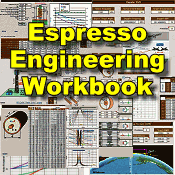 The newest release of RF Cafe's spreadsheet
(Excel) based engineering and science calculator is now available -
Espresso Engineering Workbook™. Among other additions, it now has a Butterworth
Bandpass Calculator, and a Highpass Filter Calculator that does not just gain, but
also phase and group delay! Since 2002,
the original Calculator Workbook has been available as a free download.
Continuing the tradition, RF Cafe Espresso Engineering Workbook™ is
also provided at no cost,
compliments of my generous sponsors. The original calculators are included, but
with a vastly expanded and improved user interface. Error-trapped user input cells
help prevent entry of invalid values. An extensive use of Visual Basic for Applications
(VBA) functions now do most of the heavy lifting with calculations, and facilitates
a wide user-selectable choice of units for voltage, frequency, speed, temperature,
power, wavelength, weight, etc. In fact, a full page of units conversion calculators
is included. A particularly handy feature is the ability to specify the the number
of significant digits to display. Drop-down menus are provided for convenience... The newest release of RF Cafe's spreadsheet
(Excel) based engineering and science calculator is now available -
Espresso Engineering Workbook™. Among other additions, it now has a Butterworth
Bandpass Calculator, and a Highpass Filter Calculator that does not just gain, but
also phase and group delay! Since 2002,
the original Calculator Workbook has been available as a free download.
Continuing the tradition, RF Cafe Espresso Engineering Workbook™ is
also provided at no cost,
compliments of my generous sponsors. The original calculators are included, but
with a vastly expanded and improved user interface. Error-trapped user input cells
help prevent entry of invalid values. An extensive use of Visual Basic for Applications
(VBA) functions now do most of the heavy lifting with calculations, and facilitates
a wide user-selectable choice of units for voltage, frequency, speed, temperature,
power, wavelength, weight, etc. In fact, a full page of units conversion calculators
is included. A particularly handy feature is the ability to specify the the number
of significant digits to display. Drop-down menus are provided for convenience...
Tuesday the 5th
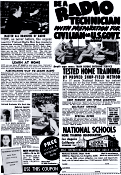 In the original radio broadcast version
of "A Christmas Story," author and New York City's WOR station talk show personality
Jean Shepherd mentions how during the Great Depression, desperate men fell victim
to the magazine ads promising fortunes to be made repairing radios. Some, of course,
actually succeeded, but doing so was difficult without substantial financial resources
to fund test equipment, inventory, transportation, a workshop, etc., to get started.
Two things electronics servicemen had in their favor at the time this National Schools
Radio Home Training ad appeared in the October 1942 issue of Popular Electronics
magazine was that many service-age men were going off to fight the Axis forces (or
were planning to go), and that new radio production had ceased in order to dedicate
resources to the war effort, so replacing a broken radio with a new one was not
an option. The copy appeals to both the man aspiring to run his own business and
the man planning to apply his knowledge and services to the military... In the original radio broadcast version
of "A Christmas Story," author and New York City's WOR station talk show personality
Jean Shepherd mentions how during the Great Depression, desperate men fell victim
to the magazine ads promising fortunes to be made repairing radios. Some, of course,
actually succeeded, but doing so was difficult without substantial financial resources
to fund test equipment, inventory, transportation, a workshop, etc., to get started.
Two things electronics servicemen had in their favor at the time this National Schools
Radio Home Training ad appeared in the October 1942 issue of Popular Electronics
magazine was that many service-age men were going off to fight the Axis forces (or
were planning to go), and that new radio production had ceased in order to dedicate
resources to the war effort, so replacing a broken radio with a new one was not
an option. The copy appeals to both the man aspiring to run his own business and
the man planning to apply his knowledge and services to the military...
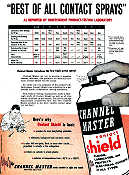 Ask anyone who has ever asked me to fix
something electrical or electronic and they will tell you my motto on such things,
born of extensive experience, is that the vast majority of the problems are caused
by poor electrical contacts of one form or another. The culprit can be a dirty or
broken connector, a cold or broken solder joint, a dirty potentiometer (contact
between wiper and resistor), etc. I have repaired everything from ceiling lights,
to car starters, to kitchen appliances, to large screen TVs simply by finding and
repairing connections. When possible, I always do a final cleaning with isopropyl
alcohol and then spray with a silicon contact protector. This
Contact Shield product from Channel Master would be a good choice. I can honestly
say I cannot think of a single instance where the restored connection failed again.
Of course sometimes it is not that simple, but enough that my initial approach to
troubleshooting - unless a broken or burnt component is immediately apparent - is
to unplug and inspect connectors (then plug-unplug-plug to wipe contacts clean),
flip switches on-off a few times while applying various directional forces (left-right,
up-down, twisting), tugging on wires, etc. People's eyes light up in amazement when
a sophisticated piece of equipment starts working after doing so. Then, I meticulously
test and clean all other easily accessible connections... Ask anyone who has ever asked me to fix
something electrical or electronic and they will tell you my motto on such things,
born of extensive experience, is that the vast majority of the problems are caused
by poor electrical contacts of one form or another. The culprit can be a dirty or
broken connector, a cold or broken solder joint, a dirty potentiometer (contact
between wiper and resistor), etc. I have repaired everything from ceiling lights,
to car starters, to kitchen appliances, to large screen TVs simply by finding and
repairing connections. When possible, I always do a final cleaning with isopropyl
alcohol and then spray with a silicon contact protector. This
Contact Shield product from Channel Master would be a good choice. I can honestly
say I cannot think of a single instance where the restored connection failed again.
Of course sometimes it is not that simple, but enough that my initial approach to
troubleshooting - unless a broken or burnt component is immediately apparent - is
to unplug and inspect connectors (then plug-unplug-plug to wipe contacts clean),
flip switches on-off a few times while applying various directional forces (left-right,
up-down, twisting), tugging on wires, etc. People's eyes light up in amazement when
a sophisticated piece of equipment starts working after doing so. Then, I meticulously
test and clean all other easily accessible connections...
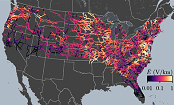 The March 2024 issue of Astronomy
magazine included this map of the U.S. showing a geoelectric hazard map for our
high-voltage transmission grid. I found what appears to be the source of the information
in a USGS (U.S. Geological Survey) paper entitled, "A
100-year Geoelectric Hazard Analysis for the U.S. High-Voltage Power Grid."
The Astronomy piece discussed possible world-ending scenarios whose Armageddon-style
event would be triggered from a space-based source. It included an asteroid strike,
a massive influx of gamma rays from a supernova, a cataclysmic collapse or reversal
of the Earth's magnetic field, and, regarding this thumbnail image, a significant
coronal mass ejection from our own star. The renown
Carrington Event which
occurred in 1959 resulted in worldwide auroral displays in both hemispheres, and
voltages induced in telegraph lines caused sparking between conductors and in connected
equipment. There was no electric power distribution system at the time (Edison and
Tesla had not yet begun their
War of the Currents) or it would have experienced significant interruptions.
Nowadays we have both ground- and space-based systems at risk. I'd stock up on some
Doomsday food supplies, but I'd rather not be around to experience the aftermath. The March 2024 issue of Astronomy
magazine included this map of the U.S. showing a geoelectric hazard map for our
high-voltage transmission grid. I found what appears to be the source of the information
in a USGS (U.S. Geological Survey) paper entitled, "A
100-year Geoelectric Hazard Analysis for the U.S. High-Voltage Power Grid."
The Astronomy piece discussed possible world-ending scenarios whose Armageddon-style
event would be triggered from a space-based source. It included an asteroid strike,
a massive influx of gamma rays from a supernova, a cataclysmic collapse or reversal
of the Earth's magnetic field, and, regarding this thumbnail image, a significant
coronal mass ejection from our own star. The renown
Carrington Event which
occurred in 1959 resulted in worldwide auroral displays in both hemispheres, and
voltages induced in telegraph lines caused sparking between conductors and in connected
equipment. There was no electric power distribution system at the time (Edison and
Tesla had not yet begun their
War of the Currents) or it would have experienced significant interruptions.
Nowadays we have both ground- and space-based systems at risk. I'd stock up on some
Doomsday food supplies, but I'd rather not be around to experience the aftermath.
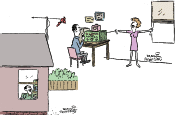 Yes, it's only Tuesday when this was posted,
but at least it's not Monday.
Electronics-themed comics appeared regularly in vintage trade magazines, like
this 1973 issue of Popular Electronics. Some of the older ones require
a knowledge of the norms and practices of the era. I'm not quite sure whether in
the page 16 comic the beast impaled himself on the antenna, or is merely perched
on it. Regardless, it is a welcome occurrence by the enthusiastic Ham radio guy.
Maybe the field interruption adjusted his beam right where he needed it, or maybe
he planned on his aerial doing double-duty as a fowl hunting (as opposed to fox
hunting) device. RF Cafe officially does not recommend that anyone try using the
temporary solution for a too-short antenna cable shown in the one comic, especially
if the rig will be transmitting anywhere maximum legal output power... Yes, it's only Tuesday when this was posted,
but at least it's not Monday.
Electronics-themed comics appeared regularly in vintage trade magazines, like
this 1973 issue of Popular Electronics. Some of the older ones require
a knowledge of the norms and practices of the era. I'm not quite sure whether in
the page 16 comic the beast impaled himself on the antenna, or is merely perched
on it. Regardless, it is a welcome occurrence by the enthusiastic Ham radio guy.
Maybe the field interruption adjusted his beam right where he needed it, or maybe
he planned on his aerial doing double-duty as a fowl hunting (as opposed to fox
hunting) device. RF Cafe officially does not recommend that anyone try using the
temporary solution for a too-short antenna cable shown in the one comic, especially
if the rig will be transmitting anywhere maximum legal output power...
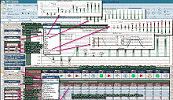 RF Cascade Workbook is the next phase in the evolution of RF Cafe's long-running
series, RF Cascade Workbook. Chances are you have never used a spreadsheet
quite like this (click
here for screen capture). It is a full-featured RF system cascade parameter
and frequency planner that includes filters and mixers for a mere $45. Built in
MS Excel, using RF Cascade Workbook is a cinch and the format
is entirely customizable. It is significantly easier and faster than using a multi-thousand
dollar simulator when a high level system analysis is all that is needed...
RF Cascade Workbook is the next phase in the evolution of RF Cafe's long-running
series, RF Cascade Workbook. Chances are you have never used a spreadsheet
quite like this (click
here for screen capture). It is a full-featured RF system cascade parameter
and frequency planner that includes filters and mixers for a mere $45. Built in
MS Excel, using RF Cascade Workbook is a cinch and the format
is entirely customizable. It is significantly easier and faster than using a multi-thousand
dollar simulator when a high level system analysis is all that is needed...
Monday the 4th
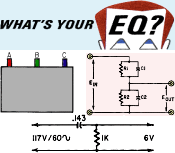 Here are a few brain exercises for starting
a new week. They appeared in the 1964 issue of Radio-Electronics magazine
in the "What's
Your EQ?" feature (EQ = Electronics Quotient). E.D. Clark created over the span
of a many years based on suggestions from readers. It's easy to over-think the first
one, but the provided answer is more of an Occam's razor approach. The Black Box
challenges can be difficult, partly because IMO the problem statement is not always
clearly presented regarding what is an is not permitted as part of the solution.
Here, for instance, it begins "Voltmeter tests read zero between any two terminals,
so an ohmmeter (VTVM type) is connected to measure resistance." Since sometimes
the generic term "voltmeter" is used in reference to a multimeter, the shift in
the sentence from volts to ohms can be confusing. The zero is volts. Note that only
semiconductors (diodes, transistors, etc.) are ruled out as part of the solution,
not electromechanical devices. For the last one, be sure to note the restriction
on frequency response... Here are a few brain exercises for starting
a new week. They appeared in the 1964 issue of Radio-Electronics magazine
in the "What's
Your EQ?" feature (EQ = Electronics Quotient). E.D. Clark created over the span
of a many years based on suggestions from readers. It's easy to over-think the first
one, but the provided answer is more of an Occam's razor approach. The Black Box
challenges can be difficult, partly because IMO the problem statement is not always
clearly presented regarding what is an is not permitted as part of the solution.
Here, for instance, it begins "Voltmeter tests read zero between any two terminals,
so an ohmmeter (VTVM type) is connected to measure resistance." Since sometimes
the generic term "voltmeter" is used in reference to a multimeter, the shift in
the sentence from volts to ohms can be confusing. The zero is volts. Note that only
semiconductors (diodes, transistors, etc.) are ruled out as part of the solution,
not electromechanical devices. For the last one, be sure to note the restriction
on frequency response...
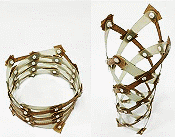 "A lightweight, easily transportable antenna
that can communicate reliably with either satellites or terrestrial devices depending
on its spatial configuration could prove useful for coordinating disaster relief
efforts. The
helix-based device, which resembles a child's finger-trap toy, switches between
its two operating modes as it is extended and contracted and could also be deployed
in space or in areas that currently lack good communications infrastructure. Developed
by researchers at Stanford University in the US and the American University of Beirut
(AUB) in Lebanon, the new antenna has a mass of just 39 g and consists of counter-rotating
helical strips that are connected by rotational joints and made from polymer fibre
composites containing a conductive mesh. In its shortened configuration, it resembles
a ring just over 2.5 cm thick and 12 cm across and can be used for targeted
satellite communications. When extended, it forms a thin cylinder about 30 cm
tall that sends signals in all directions, like a WiFi router. This adaptability
is crucial for post-disaster search and rescue operations, explains Joseph Costantine,
an electrical and computer engineer at AUB who co-led the antenna's development
together with Stanford aerospace engineer Maria Sakovsky. When deployed, the antenna
is mounted on a custom ground plane that reflects radio waves while allowing the
antenna base to slide and change shape..." "A lightweight, easily transportable antenna
that can communicate reliably with either satellites or terrestrial devices depending
on its spatial configuration could prove useful for coordinating disaster relief
efforts. The
helix-based device, which resembles a child's finger-trap toy, switches between
its two operating modes as it is extended and contracted and could also be deployed
in space or in areas that currently lack good communications infrastructure. Developed
by researchers at Stanford University in the US and the American University of Beirut
(AUB) in Lebanon, the new antenna has a mass of just 39 g and consists of counter-rotating
helical strips that are connected by rotational joints and made from polymer fibre
composites containing a conductive mesh. In its shortened configuration, it resembles
a ring just over 2.5 cm thick and 12 cm across and can be used for targeted
satellite communications. When extended, it forms a thin cylinder about 30 cm
tall that sends signals in all directions, like a WiFi router. This adaptability
is crucial for post-disaster search and rescue operations, explains Joseph Costantine,
an electrical and computer engineer at AUB who co-led the antenna's development
together with Stanford aerospace engineer Maria Sakovsky. When deployed, the antenna
is mounted on a custom ground plane that reflects radio waves while allowing the
antenna base to slide and change shape..."
 For most needs to
measure voltage, current, and resistance, modern users of test equipment do
not need to give much thought to the electrical characteristics of the instrument
being used. Other than setting the function switch to the proper position (ohms,
volts, amps, milliamps, etc.) and not exceeding the safe input limits, measurement
accuracy can usually be assumed to be good to within ±2 to ±5 of the least significant
displayed digit. I.e., if the digital display shows 10.000, then the actual value
is likely in the range of 9.995 to 10.005. Autoranging even removes the need to
manually determine the proper range setting. For critical measurements, of course,
you need to actually read the documentation to get actual accuracy ranges. One critical
electrical parameter of a meter is its input impedance, since its value affects
the voltage / current division at the measurement point. An extreme example is where
you want to measure the voltage of a unit under test (UUT) that has a 100 kΩ
impedance and an open circuit voltage of 1 volt, and the meter also has in input
impedance of 100 kΩ, the reported voltage will be 0.5 V... For most needs to
measure voltage, current, and resistance, modern users of test equipment do
not need to give much thought to the electrical characteristics of the instrument
being used. Other than setting the function switch to the proper position (ohms,
volts, amps, milliamps, etc.) and not exceeding the safe input limits, measurement
accuracy can usually be assumed to be good to within ±2 to ±5 of the least significant
displayed digit. I.e., if the digital display shows 10.000, then the actual value
is likely in the range of 9.995 to 10.005. Autoranging even removes the need to
manually determine the proper range setting. For critical measurements, of course,
you need to actually read the documentation to get actual accuracy ranges. One critical
electrical parameter of a meter is its input impedance, since its value affects
the voltage / current division at the measurement point. An extreme example is where
you want to measure the voltage of a unit under test (UUT) that has a 100 kΩ
impedance and an open circuit voltage of 1 volt, and the meter also has in input
impedance of 100 kΩ, the reported voltage will be 0.5 V...
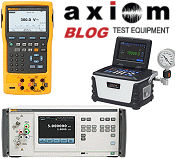 Axiom Test Equipment, an electronic test
equipment rental and sales company has published a new blog post that covers the
way calibrators offer the precision needed to evaluate in-process testers and how
they can securely deliver test results to a control center to effectively manage
an industrial process. For effective process test
equipment calibration, a calibrator must be a source of precisely controlled
parameters as well as a highly accurate measuring tool for evaluating the same parameters.
A calibrator must often inject a parameter, such as voltage, current, pressure,
or temperature, into the process equipment under test to determine the condition
of the equipment. Traditionally, data transfers to and from a calibrator were handled
by dedicated communications equipment. But growing demand for mobility and portability
in calibrators capable of in-field use has resulted in calibrators and communicators
often within the same package. When equipped with suitable communications interfaces,
such as Ethernet or Bluetooth, calibrator/communication devices can quickly and
seamlessly make their connections to the process equipment to be tested as well
as to a control center... Axiom Test Equipment, an electronic test
equipment rental and sales company has published a new blog post that covers the
way calibrators offer the precision needed to evaluate in-process testers and how
they can securely deliver test results to a control center to effectively manage
an industrial process. For effective process test
equipment calibration, a calibrator must be a source of precisely controlled
parameters as well as a highly accurate measuring tool for evaluating the same parameters.
A calibrator must often inject a parameter, such as voltage, current, pressure,
or temperature, into the process equipment under test to determine the condition
of the equipment. Traditionally, data transfers to and from a calibrator were handled
by dedicated communications equipment. But growing demand for mobility and portability
in calibrators capable of in-field use has resulted in calibrators and communicators
often within the same package. When equipped with suitable communications interfaces,
such as Ethernet or Bluetooth, calibrator/communication devices can quickly and
seamlessly make their connections to the process equipment to be tested as well
as to a control center...
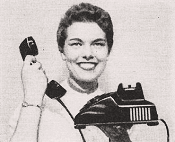 If you thought that
custom ringtones have only been around since the mobile phone, you will be surprised
to learn that according to this news brief in a 1956 issue of Popular Electronics
magazine, Bell Telephone Labs was experimenting with such features. Bell was exploiting
the convenience, small size, and relatively inexpensive transistor to enable customers
with deeper pockets to hear something other than the standard mechanical bell ringer.
The irony is, of course, that some people nowadays use a ringtone in their smartphones
that sounds like the old mechanical ringer. Evidently the custom ringtones never
went over too big for Bell because I don't remember ever hearing one in the 1960s,
70s, and 80s, and there is not a plethora of them for sale on eBay today. Being
able to differentiate your own phone's ring in the midst of an environment with
potentially a dozen or more other phones was not exactly a huge concern then. BTW,
it wasn't until 1982 that Bell Telephone was broken up into regional "Baby Bells..." If you thought that
custom ringtones have only been around since the mobile phone, you will be surprised
to learn that according to this news brief in a 1956 issue of Popular Electronics
magazine, Bell Telephone Labs was experimenting with such features. Bell was exploiting
the convenience, small size, and relatively inexpensive transistor to enable customers
with deeper pockets to hear something other than the standard mechanical bell ringer.
The irony is, of course, that some people nowadays use a ringtone in their smartphones
that sounds like the old mechanical ringer. Evidently the custom ringtones never
went over too big for Bell because I don't remember ever hearing one in the 1960s,
70s, and 80s, and there is not a plethora of them for sale on eBay today. Being
able to differentiate your own phone's ring in the midst of an environment with
potentially a dozen or more other phones was not exactly a huge concern then. BTW,
it wasn't until 1982 that Bell Telephone was broken up into regional "Baby Bells..."
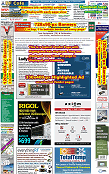 Banner Ads are rotated in all locations
on the page! RF Cafe typically receives 8,000-15,000 visits each
weekday. RF Cafe
is a favorite of engineers, technicians, hobbyists, and students all over the world.
With more than 17,000 pages in the Google search index, RF Cafe returns in
favorable positions on many types of key searches, both for text and images.
Your Banner Ads are displayed on average 280,000 times per year! New content
is added on a daily basis, which keeps the major search engines interested enough
to spider it multiple times each day. Items added on the homepage often can be found
in a Google search within a few hours of being posted. If you need your company
news to be seen, RF Cafe is the place to be... Banner Ads are rotated in all locations
on the page! RF Cafe typically receives 8,000-15,000 visits each
weekday. RF Cafe
is a favorite of engineers, technicians, hobbyists, and students all over the world.
With more than 17,000 pages in the Google search index, RF Cafe returns in
favorable positions on many types of key searches, both for text and images.
Your Banner Ads are displayed on average 280,000 times per year! New content
is added on a daily basis, which keeps the major search engines interested enough
to spider it multiple times each day. Items added on the homepage often can be found
in a Google search within a few hours of being posted. If you need your company
news to be seen, RF Cafe is the place to be...
Friday the 1st
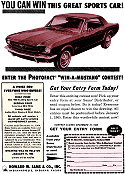 Sam's Photofact® was the world's premier
publisher of service documentation for nearly every make and model of radio, television,
tape deck, projector, phonograph, and other domestic type products. By 1964 when
this ad appeared in Radio-Electronics magazine, a service shop which owned
a copy of every service pack ever printed had probably half a dozen file cabinets
filled with folders. Manufacturers typically did not make such information available
to the general public or even to shops that did not have service agreements with
them. Except for some condensed versions published by magazines, and a couple other
minor datapack vendors, Sam's was it. A contest drawing was used when the Ford Mustang
first came out that offered a free car to the first place winner. As the ad thumbnail
shows, the initial MSRP for the 1965 Mustang was a whopping $2,368 --- the equivalent
of about $23,408 in 2024 money. That, of course, was the base price. It's hard to
believe, but the base 2024 Mustang is only $30,920. That's 32% more than the 1965
base model, but the base today has a lot more features than in 1965. Fortunately,
the new Mustangs do not feature an explode-on-impact gas tank behind the rear seat... Sam's Photofact® was the world's premier
publisher of service documentation for nearly every make and model of radio, television,
tape deck, projector, phonograph, and other domestic type products. By 1964 when
this ad appeared in Radio-Electronics magazine, a service shop which owned
a copy of every service pack ever printed had probably half a dozen file cabinets
filled with folders. Manufacturers typically did not make such information available
to the general public or even to shops that did not have service agreements with
them. Except for some condensed versions published by magazines, and a couple other
minor datapack vendors, Sam's was it. A contest drawing was used when the Ford Mustang
first came out that offered a free car to the first place winner. As the ad thumbnail
shows, the initial MSRP for the 1965 Mustang was a whopping $2,368 --- the equivalent
of about $23,408 in 2024 money. That, of course, was the base price. It's hard to
believe, but the base 2024 Mustang is only $30,920. That's 32% more than the 1965
base model, but the base today has a lot more features than in 1965. Fortunately,
the new Mustangs do not feature an explode-on-impact gas tank behind the rear seat...
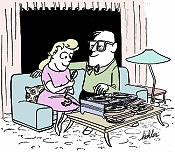 This 1956-vintage Popular Electronics
magazine article by techno-kidder
Carl Kohler taught me a new word - "darb," as in "Isn't that a darb, now." According
to Merriam-Webster, a darb is a slang term for something superlative. Mr. Kohler
penned many tongue-in-cheek stories for Popular Electronics in the 1950s
and 1960s, all of them based on his antics involving the latest electronics gadget
and Mrs. Kohler's reaction to them. Maybe they are real (in this case, "reel")
and maybe not, but regardless, they are funny and even if made up, could easily
be actual experiences. A list of the other Kohler sagas is given below... This 1956-vintage Popular Electronics
magazine article by techno-kidder
Carl Kohler taught me a new word - "darb," as in "Isn't that a darb, now." According
to Merriam-Webster, a darb is a slang term for something superlative. Mr. Kohler
penned many tongue-in-cheek stories for Popular Electronics in the 1950s
and 1960s, all of them based on his antics involving the latest electronics gadget
and Mrs. Kohler's reaction to them. Maybe they are real (in this case, "reel")
and maybe not, but regardless, they are funny and even if made up, could easily
be actual experiences. A list of the other Kohler sagas is given below...
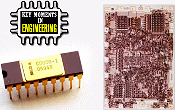 "What was once
considered a bad business venture, the 8008's lasting legacy went on to drive
the technological world we live in today. Computer Terminal Corporation (now defunct
Datapoint) launched the DataPoint 3300 computer terminal in 1969 as a platform to
replace teleprinters, or the precursors to fax machines. The machine was implemented
using TTL logic in a mix of small- and medium-scale integrated circuits (ICs), which
could produce an enormous amount of heat during operation. When the terminal was
announced in 1967, RAM was extremely expensive (and heavy). So, the DataPoint terminal
stored its display of 25 rows of 72 columns of upper-case characters using fifty-four
200-bit shift registers, arranged in six tracks of nine packs each, providing shift
register memory for 1,800 6-bit characters. To address the excessive heat and other
issues, CTC designed the DataPoint 3300's predecessor with a CPU, placing all of
those ICs on a single chip. CTC co-founder Austin Roche looked to Intel to help
with the endeavor, as the company was well known for being a primary vendor of RAM
chips at the time..." "What was once
considered a bad business venture, the 8008's lasting legacy went on to drive
the technological world we live in today. Computer Terminal Corporation (now defunct
Datapoint) launched the DataPoint 3300 computer terminal in 1969 as a platform to
replace teleprinters, or the precursors to fax machines. The machine was implemented
using TTL logic in a mix of small- and medium-scale integrated circuits (ICs), which
could produce an enormous amount of heat during operation. When the terminal was
announced in 1967, RAM was extremely expensive (and heavy). So, the DataPoint terminal
stored its display of 25 rows of 72 columns of upper-case characters using fifty-four
200-bit shift registers, arranged in six tracks of nine packs each, providing shift
register memory for 1,800 6-bit characters. To address the excessive heat and other
issues, CTC designed the DataPoint 3300's predecessor with a CPU, placing all of
those ICs on a single chip. CTC co-founder Austin Roche looked to Intel to help
with the endeavor, as the company was well known for being a primary vendor of RAM
chips at the time..."
 Although not routinely referred to as plasma
displays at the time, the "thin
TV displays" reported in this 1973 article in Popular Electronics magazine
was one of the first instances of commercially viable schemes. According to Wikipedia,
Fujitsu introduced the first full-color plasma display panel (PDP) in 1992 - with
a 21" screen - two decades after this device 80x212-pixel monochrome designed by
Zenith. I remember seeing the 42" Fujitsu plasma TVs in Best Buy with a $10,000
price tag sometime in the mid 1990s, which jives with Fujitsu's stated plan of selling
the first units at around 1 million yen (~$8,800 at today's exchange rate). Prior
to the advent of plasma displays, rear-projection screen televisions were the main
way to get really large displays. While rear-projection displays suffered from narrow
viewing angles, plasma displays suffered from pixel burn-in that gradually reduced
contrast to annoyingly low levels. Both options carried a relatively large price
tag compared to 25" and 27" CRT televisions... Although not routinely referred to as plasma
displays at the time, the "thin
TV displays" reported in this 1973 article in Popular Electronics magazine
was one of the first instances of commercially viable schemes. According to Wikipedia,
Fujitsu introduced the first full-color plasma display panel (PDP) in 1992 - with
a 21" screen - two decades after this device 80x212-pixel monochrome designed by
Zenith. I remember seeing the 42" Fujitsu plasma TVs in Best Buy with a $10,000
price tag sometime in the mid 1990s, which jives with Fujitsu's stated plan of selling
the first units at around 1 million yen (~$8,800 at today's exchange rate). Prior
to the advent of plasma displays, rear-projection screen televisions were the main
way to get really large displays. While rear-projection displays suffered from narrow
viewing angles, plasma displays suffered from pixel burn-in that gradually reduced
contrast to annoyingly low levels. Both options carried a relatively large price
tag compared to 25" and 27" CRT televisions...
 The newest release of RF Cafe's spreadsheet
(Excel) based engineering and science calculator is now available -
Espresso Engineering Workbook™. Among other additions, it now has a Butterworth
Bandpass Calculator, and a Highpass Filter Calculator that does not just gain, but
also phase and group delay! Since 2002,
the original Calculator Workbook has been available as a free download.
Continuing the tradition, RF Cafe Espresso Engineering Workbook™ is
also provided at no cost,
compliments of my generous sponsors. The original calculators are included, but
with a vastly expanded and improved user interface. Error-trapped user input cells
help prevent entry of invalid values. An extensive use of Visual Basic for Applications
(VBA) functions now do most of the heavy lifting with calculations, and facilitates
a wide user-selectable choice of units for voltage, frequency, speed, temperature,
power, wavelength, weight, etc. In fact, a full page of units conversion calculators
is included. A particularly handy feature is the ability to specify the the number
of significant digits to display. Drop-down menus are provided for convenience... The newest release of RF Cafe's spreadsheet
(Excel) based engineering and science calculator is now available -
Espresso Engineering Workbook™. Among other additions, it now has a Butterworth
Bandpass Calculator, and a Highpass Filter Calculator that does not just gain, but
also phase and group delay! Since 2002,
the original Calculator Workbook has been available as a free download.
Continuing the tradition, RF Cafe Espresso Engineering Workbook™ is
also provided at no cost,
compliments of my generous sponsors. The original calculators are included, but
with a vastly expanded and improved user interface. Error-trapped user input cells
help prevent entry of invalid values. An extensive use of Visual Basic for Applications
(VBA) functions now do most of the heavy lifting with calculations, and facilitates
a wide user-selectable choice of units for voltage, frequency, speed, temperature,
power, wavelength, weight, etc. In fact, a full page of units conversion calculators
is included. A particularly handy feature is the ability to specify the the number
of significant digits to display. Drop-down menus are provided for convenience...
These archive pages are provided in order to make it easier for you to find items
that you remember seeing on the RF Cafe homepage. Of course probably the easiest
way to find anything on the website is to use the "Search
RF Cafe" box at the top of every page.
About RF Cafe.
Homepage Archive Pages
2024:
Jan |
Feb |
Mar |
Apr |
May |
Jun |
Jul |
Aug |
Sep |
Oct |
Nov |
Dec
2023:
Jan |
Feb |
Mar |
Apr |
May |
Jun |
Jul |
Aug |
Sep |
Oct |
Nov |
Dec
2022:
Jan |
Feb |
Mar |
Apr |
May |
Jun |
Jul |
Aug |
Sep |
Oct |
Nov |
Dec
2021:
Jan |
Feb |
Mar |
Apr |
May |
Jun |
Jul |
Aug |
Sep |
Oct |
Nov |
Dec
2020:
Jan |
Feb |
Mar |
Apr |
May |
Jun |
Jul |
Aug |
Sep |
Oct |
Nov |
Dec
2019:
Jan |
Feb |
Mar |
Apr |
May |
Jun |
Jul |
Aug |
Sep |
Oct |
Nov |
Dec
2018:
Jan |
Feb |
Mar |
Apr |
May |
Jun |
Jul |
Aug |
Sep |
Oct |
Nov |
Dec
2017:
Jan |
Feb |
Mar |
Apr |
May |
Jun |
Jul |
Aug |
Sep |
Oct |
Nov |
Dec
2016:
Jan |
Feb |
Mar |
Apr |
May |
Jun |
Jul |
Aug |
Sep |
Oct |
Nov |
Dec
2015:
Jan |
Feb |
Mar |
Apr |
May |
Jun |
Jul |
Aug |
Sep |
Oct |
Nov |
Dec
2014:
Jan |
Feb |
Mar |
Apr |
May |
Jun |
Jul |
Aug |
Sep |
Oct |
Nov |
Dec
2013:
Jan |
Feb |
Mar |
Apr |
May |
Jun |
Jul |
Aug |
Sep |
Oct |
Nov |
Dec
2012:
1 |
2 |
3 |
4 |
5 |
6 |
7 |
8 |
9 |
10 |
11 |
12 |
13 (no archives before 2012)
|










 Do
you have a copy of Visual Basic v6.0 Professional or Enterprise that you are
willing to sell or swap for RF Cafe software? My VB6 was sold long ago, but now
I would like to work on some old programs. Believe it or not, VB6 programs will
still run on Windows 11.
Do
you have a copy of Visual Basic v6.0 Professional or Enterprise that you are
willing to sell or swap for RF Cafe software? My VB6 was sold long ago, but now
I would like to work on some old programs. Believe it or not, VB6 programs will
still run on Windows 11.



 Werbel Microwave
Werbel Microwave















 Sam's Photofact®
Sam's Photofact®


